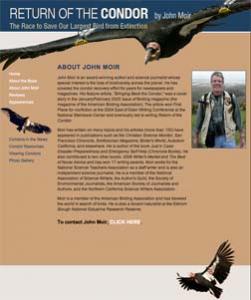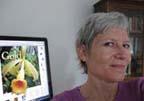By Nancy Allison
This month's Q&A owes a lot to serendipity. While searching the Internet for books on one of the giants of environmental history, I mistyped his surname by one letter. Thanks to the typo, up popped a link to the site of contemporary conservationist and writer John Moir.
At the time, I had no idea that Moir was a prize-winning science journalist and book author. All I knew was what the "snippet," or webpage descriptor said: That he had written Return of the Condor, "a riveting account of one of the most dramatic attempts to save a species from extinction in the history of modern conservation."
I was hooked. I had to click that link. And when I did, the wings of a condor embraced a blissfully simple page containing a brief description of Moir's accomplishments as a science writer. A menu on the left offered links to info about the book, reviews, news about condors, photos, and resources. I was so fascinated that I forgot the time, forgot my research, and in the end, clicked on the Amazon link provided and bought the book. Looks like the site is working!
NA: John, your site is a lesson in perfect packaging. Did you create the Condor site in advance of your book? Did your publisher help at all, or did you do it yourself?
JM: I purchased the domain name as soon as we decided on the book title, but I was so busy that the website itself didn't go online until the month the book was released. It turned out to be no big deal, although ideally a website would be operating before the book comes out to help with pre-publication publicity.
And no, the publisher did not have enough in their promotion budget to develop the website (although they were happy to lavish the website with praise when it appeared!). I hired Kat and Mouse Web Design to help me with it, and I'm glad I did. I am a writer, not a web designer.
NA: You have a striking yet refreshingly uncomplicated site. What were your goals for the site and is it meeting them?
JM: I wanted an easy-to-use and professional-looking website. We strived to create a design that was simple and appealing. I love having the website, and it's hands-down my best marketing tool. It links me to the world by helping to promote the book, provide information on my work, and act as a resource for anyone interested in condors. The website has served remarkably well in achieving all these goals.
It is also a powerful way for me to connect with readers who regularly contact me through the website. People write to say they enjoyed the book, ask questions, or to correspond about my work. I've received contacts from as far away as Nepal. It's wonderful, and I always make a point of replying to readers.
NA: Do you have a counter, and if so, do you watch how many readers you are getting?JM: Yes, my website is hosted by GoDaddy and the counters they provide are quite sophisticated and useful. I can track the increase in hits when I've given a talk or an interview. It helps provide a rough idea of what publicity is working.
NA: What about using site optimization tactics to try and get the website noticed?
JM: My web designer helped in maximizing keywords and getting the website visible on Google. If you Google "John Moir," my website is now the first two hits. But it can take weeks or even months for that to happen. I'm told that Google puts new websites into a somewhat mysterious category known as the "sandbox." This is a holding area for new domains that acts as an aging filter and a buffer against new websites that try to artificially inflate their popularity. There is some debate as to whether the sandbox really exists, but I believe it does. We found that despite our best efforts, it took a while for my website to become visible.
NA: I was amazed at how quickly you responded to my query when I used your contact page. Has the contact form proved effective in terms of invitations to do readings or give interviews?
JM: The contact form has been an excellent way for organizations and journalists to connect with me for talks and interviews. It's also a place where editors show up asking for stories. For example, I just completed an article for the in-flight magazine for Korean Airlines whose editor contacted me through the website.
NA: Has the site helped you to sell your book? Is there a way to tell whether someone clicked through to Amazon via the link on your site ... and then actually bought a book?
JM: The website has definitely helped with book sales. Since my name is John Moir and not John Grisham, my books don't get a huge display at the front of bookstores. The website helps me to compete.
And yes, Amazon has a program called Amazon Associates where you can track sales generated through the website.
NA: Did you have another writing site before Return of the Condor?
JM: No, although it was something I had been planning to do.
NA: You named the site after your book. Any thoughts on choosing that route instead of using your own name for the site?
JM: At first, it worked well having the website named for the book. But as I have became more well known in the conservation and birding communities, using the book title rather than my own name has been less of an advantage. I'm now in the process of setting up a new website under my own name that will showcase all my work.
That said, I believe the most important element determining a website's success is its Google visibility. When people want to find you, whether by name or book title, they usually start with a Google search. Having a high Google ranking is crucial.
NA: You post some excellent reviews from those in the science community on the site in addition to print reviews. How did you go about getting those?
JM: I worked hard to garner the endorsements. I started with editors or scientists with whom I'd already worked. But even with them, I needed a professional approach with a succinct pitch explaining the book and asking to use their name for an endorsement (which is no small thing). There were lots of emails and left-brain-type details to attend to, such as making sure the publisher sent potential blurbers an advance copy and that the endorsement was received by our deadline.
In addition, I cast a wide net to reach "name" people by using every contact I had. In some cases, I made cold pitches. By necessity, most well-known people surround themselves with a bubble of inaccessibility. Figuring out how to pierce that bubble and persuade them to consider an endorsement is a challenge. One break that helped was when Pulitzer Prize-winner Richard Rhodes came through with an early blurb that I then could mention in pitch letters to other potential endorsers.
NA: You also have a resources page, and news items about the condor. Are these hard to keep current?
JM: More left-brain stuff! I'm not as good as I should be about keeping current. One of the challenges is that changes in my website have to be done using computer coding which is time consuming. The new website we're working on will be more user friendly.
NA: Anything you want to do with the site you are not doing now?
JM: Yes, I'm in the process of developing a presence on some of the social networking sites, such as Facebook, which I will link to the website.
NA: Thanks, John, for taking us behind the screen.
JM: Great to talk with you.
Nancy Allison writes about the fascinating research, art and scholarship occurring at universities, in galleries, and on the web. She blogs at Writer on Board. Send your web and blog picks to her at: nancy@nasw.org.




